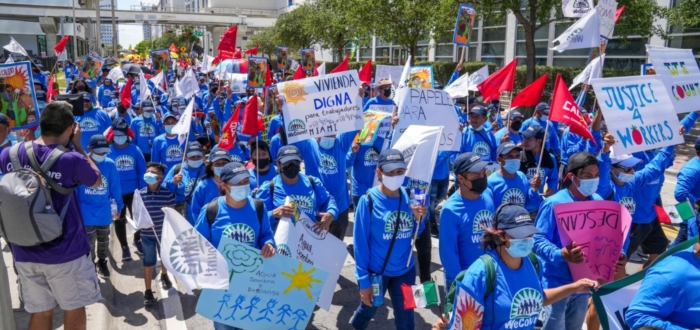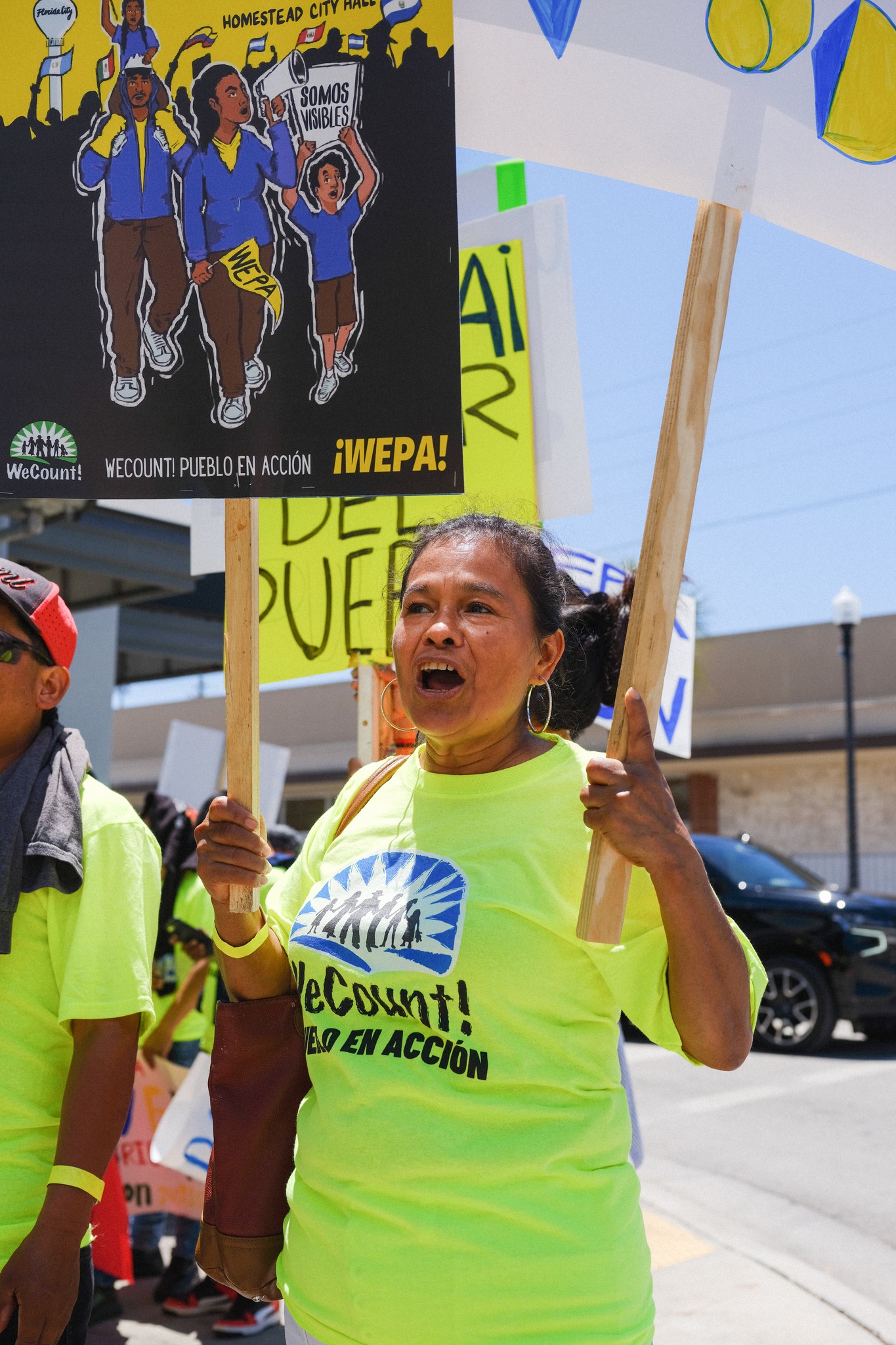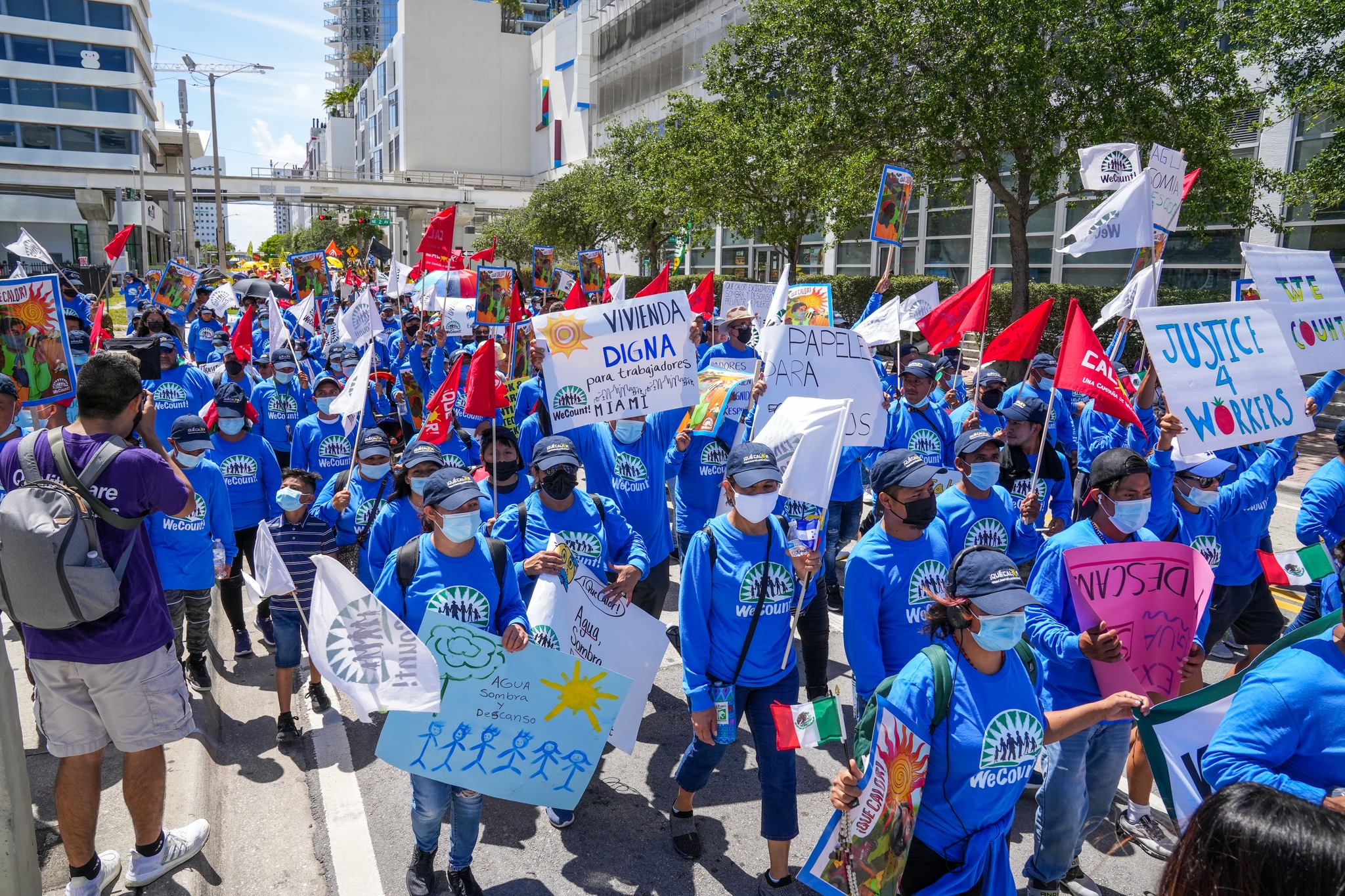
Climate justice organizers in Florida are saving lives, scoring wins, and building power in a tough political environment.
Even the National Weather Service didn’t know just how hot it was getting in Miami—or how to respond appropriately—until community members tracked and publicized the temperatures on the ground.
National Weather Service (NWS) records, which are taken at the airport, showed that Miami-Dade County had hit a heat index of 108, a critical number that unlocks government aid, only 14 times in 70 years. But a 2023 citizen science study found that some spots in the county had reached that mark more than 100 days in just a year. The research quickly led the NWS to lower its threshold for triggering heat relief measures.
As temperatures climb, Miami is one of the hottest places in the nation, obliterating records in 2023 with 46 straight days above a heat index of 100—a punishing combination of heat and humidity. The hyperlocal research led by Catalyst Miami, a grantee of The Solutions Project, is just one example of the way working class communities are showing their cities—and the rest of the country—how to respond to, and prepare for, the kind of extreme heat that is becoming a dangerous new norm. Following a presidential election that puts federal climate leadership at risk—including the very existence of the NWS— this kind of ground up work is even more important to demonstrating the impacts of a changing climate on people’s day to day lives.
Led by a coalition of labor rights, economic justice, and climate justice organizers, Miami-Dade has become a national focal point for heat resilience in recent years, appointing the world’s first Chief Heat Officer, crafting an impactful Extreme Heat Action Plan, and leading a national push for stronger worker protections—all in a state that is politically hostile to the mere mention of climate change.
The work happening in Miami is representative of a wave of impact being unleashed by climate justice organizers and funding partners like The Solutions Project (TSP). Seeking to put hard numbers to the nationwide body of work, TSP recently released a series of reports outlining the human and climate impact of these efforts in recent years, cataloging dozens of wins that are building all the way up to the highest level of national policy.
Results include major strides in the clean energy transition in leading edge markets like New York and Los Angeles, but some of the most interesting campaign wins are happening around climate resilience, even in the deepest of red states. It’s an especially important front in the global climate fight, as it provides an entry point for climate justice power-building, opens up pathways for other cities to replicate progress, and ensures that we center equity in response to the crisis—regardless of the political climate.

Since the earliest years of climate action, the movement has been bogged down by internal debates over the best plan of attack—new technology versus grassroots organizing, regulation versus market fixes, adaptation versus mitigation. The work in Miami shows that these distinctions are artificial when approaching climate change from the perspective of how it impacts real people and places.
The diverse coalition making waves in South Florida is a testament to the way climate justice organizing breaks down these climate silos, connecting solutions to accelerate action. TSP grantees include Catalyst Miami, which organizes multiracial communities around both economic and climate justice; WeCount, which represents immigrant workers mostly in agriculture; the CLEO Institute, a climate education and advocacy nonprofit; and Miami Climate Alliance, a coalition of neighborhood-based organizations, social service providers, and labor groups.
Combined, they are challenging assumptions about who is best equipped to lead on climate action. Consider Catalyst Miami’s community-led partnership with several universities to generate the impactful new heat data. Catalyst is also working with the CLEO Institute to connect frontline community members with government officials to shape policy.
Meanwhile, Florida immigrant rights group WeCount has been a powerhouse in demanding climate justice, instrumental in the appointment of Jane Gilbert as the world’s first Chief Heat Officer. “We really see the heat officer as an extension of the advocacy that we’ve been doing,” Oscar Londoño, co-executive director of WeCount, said in a Smithsonian Magazine profile of Gilbert. “We’ve offered advice and input on their messaging, their educational materials, their efforts to try to reach out to workers and their employers.”
After Gilbert took on the role, Catalyst, WeCount, and Miami Climate Alliance all participated in the creation of Miami-Dade’s Extreme Heat Action Plan, which in 2022 set in motion an ambitious platform of relief measures. In executing the plan, the county has installed over 1,700 efficient air conditioning units, planted 16,000 trees, given away another 10,000 trees to residents, updated heat response protocols, distributed cooling kits, and trained community members on heat safety.
While Miami is probably at the head of the pack, climate justice organizers, including dozens of other TSP grantees, have driven similar progress across the country, pushing states like Texas and Arizona to engage head on with climate change, and building power for further resilience and climate mitigation measures. Even as the possibility of expanding federal heat protections to workers is endangered under the new administration, the strategy continues to advance, laying the foundations for change across the country.
Heat resilience in Miami showcases a funding and organizing strategy that fuses together climate action and human needs on the ground, following the lead of those most impacted. It’s an approach that gains popularity with each passing year, as the imaginary barrier separating the abstract threat of climate change from our daily lives dissolves away like so much melted ice cream.
As much as storms like Helene and Milton provide tragic wake-up calls, the leading cause of weather-related death is still heat, and it gets hotter every year. Like other climate impacts, heat disproportionately harms low-income communities and people of color. Research has found that some affluent areas in Miami can be as much as 8 degrees Celsius cooler than the city average, and 94% of historically redlined American cities showed similar temperature swings along the lines of segregation. Unhoused residents, like those served by another TSP Miami-based grantee the Smile Trust, are at greater risk of heat-related death and illness, as are low-income housed families when inability to afford air conditioning turns homes into furnaces.
Even setting aside inequity within cities, Miami-Dade’s 2.7 million residents are 87% people of color or Spanish speaking. All of this means that the human benefits of Miami’s new heat relief measures will be widespread and challenge longstanding inequities. Greater access to AC, shade, cooling centers, and drinking water will save lives in a region that is mostly home to people of color, especially in working-class neighborhoods that are hit the hardest by weather extremes.
The new TSP research tracks similar heat resilience strides in other cities. In Austin, Texas, for example, expanded access to community swimming pools will benefit 958,000 residents, 52.3% of whom are people of color. And in Arizona, a Trees for Kids program will provide grants for mostly low-income public schools to plant new shade trees, to the benefit of 73,000 students.
These are all simple, relatively inexpensive strategies that have proven effective and popular even in politically challenging states. Well-funded campaigns to replicate them elsewhere would have exponential, life-saving impacts.

Climate-related extremes are the new reality, and as new pathways for action open up in response, the boldest efforts will lead the way for others to follow. Progress in Miami-Dade is an important case study.
Miami’s was the first Chief Heat Officer, but since Jane Gilbert was appointed in 2021, there have been at least eight new positions created, in places like Phoenix, Los Angeles, Melbourne, Athens, and Freetown in Sierra Leone. CHOs are learning from each other and exchanging ideas. They even have a WhatsApp group chat (imagine the memes).
Meanwhile, extreme heat action plans like the one created in Miami-Dade are proliferating quickly, as are heat relief toolkits, councils, and task forces. They frequently use the language and playbooks of the climate justice movement, and are unlocking public funds to respond to a threat that grows every year.
It’s worth highlighting again that many of these campaigns—located in cities in the scorching South or Southwest—are in political environments where climate action was once all but impossible. Coalitions become stronger with every campaign, and even losses push forward a sense that resistant state governments cannot ignore the crisis anymore.
Que Calor! is the latest example in Miami, a campaign run by immigrant rights group and TSP grantee WeCount. Laborers have been pushing for new safety standards that would require shade, water, and breaks for the state’s 2 million outdoor workers. On the brink of enacting protections in Miami-Dade in 2024, the Florida legislature passed legislation banning localities from doing so, essentially killing the Miami law—for now.
The Que Calor! campaign marches on with a growing coalition and bipartisan support, and the national attention it has drawn is pushing forward the discourse on worker safety. In 2024, Biden’s Department of Labor set in motion an occupational heat safety standard that would protect 36 million workers. And even as the incoming administration leaves federal protections up in the air, six other states have implemented occupational heat safety standards, and more are in the works.